It may seem to some that the Toyota Camry costs completely inadequate money in Europe. However, on closer inspection it turns out that, given the really high quality of workmanship and low maintenance costs, the purchase pays for itself over the years. Only the variant with the engine 2,4 will be really "perpetual" car. Purchase of Camry with the "big" engine 3,5 will turn out not only with the raised tax.

Brakes, suspension and steering
If one doesn't forget to lubricate guide "fingers" of calipers and timely change disks and pads, brakes are almost eternal. And the quality of original components is so high, that cars with 2,4 engines can be found with original disks and at runways under 200 thousand, and pads can easily reach a hundred. And with 3,5 the disks overheat, and pads "burn" in literal sense. The bigger weight and more aggressive driving style on the average affects it.
The handbrake mechanism is a little weak, but you rarely use it in cars with automatic transmission. To change its cables one should remove a lot of plastic trim parts, so it either doesn't work in old cars (because the ropes got stuck) or it just doesn't create the braking force. Vacuum booster leaks are very rare - this is manifested by irreparable floating revs and a hissing noise when the pedal is depressed.
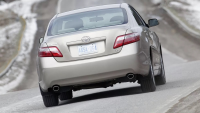
Suspension is also the sample of reliability; one may not think about it in city conditions up to one hundred thousand run. Only antiroll bars can not live up to the anniversary run.
The only disadvantage - it is necessary to drive camber regularly, including back axle. Angles of wheel alignment are gone quickly and inappropriately after a couple of trips along "directions". After 150 thousand, one will most likely have to change ball joints in front (possibly, together with levers), and to keep comfort, one will have to change strut supports and shock absorbers in front and behind.
At the back, all pull rods will require attention after hundred thousand. If a "bandage" is used instead of rubber, one will have to invest in replacement of hub bearings round. In general, there is nothing surprising; everything is standard.
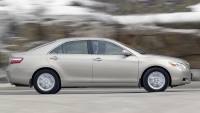
Steering is also reliably and simply arranged. Knocking of the rack is heard only with greater mileage, leaks are rare. More often the spline joint of steering column or cardan joints are knocked. Faulty steering wheel position sensors affect operation of ESP more, but it may cause steering failure in cars with hybrid powertrain, which we don't encounter so often.
Transmission
The manual is solid, as it should be. It is worth to pay attention only to leak of a transmission and condition of external CV joint covers. The transmission itself with a manual change-over will not surprise - E351 gearbox was installed on several generations of Toyota passenger cars, and it approved itself in the best shape. No fancy dual-mass flywheels, except for hydrodrive, but the bearing is separate, and hydraulics is separate. Absolutely classic and reliable design.
Some age wear does occur, though. Transmission's lever is flabby little by little, rocker arm gets backlash with the lapse of time. And the strongest persons sometimes pull the drive ropes and tear them off catches or even bend the lever. The last one, by the way, is carried out specially: initially it moves too far forward and to the right, and it is not the best solution on a wide centre console. After 150-200 thousand run, it is better to change cables - otherwise there are chances, their lugs will fly off. It is better to combine the process with replacement of clutch.
The major part of cars are equipped with automatic transmissions. Of course, all of them are made by the subsidiary Aisin. Basically, the Camry was due to five-speed automatic Aisin U250E with 2.4 engine and six-speed U660E for machines with 3.5 engine.
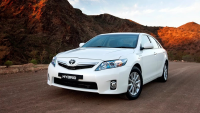
In addition to these variants, you can meet imported vehicles with other units. So, you can meet restyled cars with 2.5-motor and six-speed U760E engine, and rare all-wheel drive right-hand drive cars in our country were equipped with a four-speed U241E transmission. Hybrid trucks received e-CVT P311.
The most common is five-speed U250E/U151E, also Aisin 95-51LS. On Europe-made cars U151E version is installed more often, it is a little bit stronger. Basically, the gearbox also withstands torque of 3,3/3,5 engines - for example, it was installed on Lexus RX330. But it has not lived long and happily with powerful motors, but with 2,4 it has appeared practically eternal.
If not to abuse city racing, to change oil once in 50-60 thousand kilometres of run and the filter - at every second oil change or appearance of visible pollution, it is able to go well over 300 thousand kilometres. There are even chances to reach 500.

However, don't count on automatic luck. There are enough people who confuse Camry with Ferrari 360, and even this automatic will be gone. Races and lack of service first of all finish off solenoids of hydroblock, and untimely change of oil leads to irreparable damage of "plate" itself, its warping and overheating. The mechanics of automatic transmission also suffers: the pump bushing and glands are worn out, the transmission starts to leak. Very often, too aggressive drivers damage a back cover and burn out Overdrive and Direct clutch packs. And in neglected cases, the whole set of these packages, including the drum. But first the cover bearing will die, which is usually accompanied by a thump when engaging rear gear and shifting from second to third.
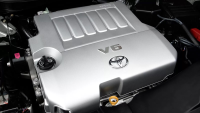
The box is well mastered in repair - "thanks" to crossovers with powerful V6 and vans. Due to this the restoration shouldn't be much of a problem. But in this case it is easier to find a contract unit: boxes from Camry are often "donors" for all-wheel drive transmissions of crossovers, because there are a lot of them and they are cheap. And it is not necessary to look for a replacement version of 3,3 engine - mechanically the transmissions do not differ, but the difference will be bigger in wear and tear.
The torque converter, it is a "bagel" (the nickname has derived from its form), is an indispensable attribute of any "real automatic". Powerful variators can do without it, and even ...
The U660E six-speed is slightly more complex in design and has a number of childhood diseases. Its variant for the weaker U760E engines came out later and therefore proved somewhat more reliable. As with many modern automatic transmissions, there is a problem with early wear of torque converter lockup linings. With run over 120-150 thousand it is already necessary to watch attentively for cleanliness of oil, for with critical wear of hydraulic converter is capable to "hammer" the channels of hydroblock very quickly and to leave the box without oil.
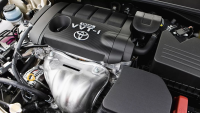
Plate wear, solenoid wear and other problems are typical. Often the selector plate with thermal sensor is also replaced. Under normal use, the service life is more than enough, over 200 thousand, but it is reduced very quickly, if one drives it aggressively. In fact, Camry with the engine 3,5 has appeared for many people as the car for "bending" everyone and everything... Remember about it.
Much more serious is other problem, which appears not in every car, but which leads to full failure of the unit. The main bearing in the housing starts to play due to the loosening of the thrust ring. It happens especially often at those who load cold automatic transmission. Vibrations in this case kill all other units, including planetary gear, friction hub, differential, and, if the situation starts, the case of the box.
Damage to the Direct drum is usually due to poor sealing of its pack - pistons and retainers need to be replaced, sometimes the drum itself is overheated. If the drum is worn out or pistons are installed incorrectly several times, the complete drum with the shaft is often replaced, but in this case only the price of spare parts exceeds 50 thousand roubles.
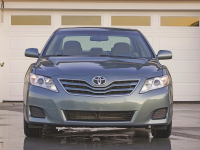
Cars after the restyling are basically equipped with an already refined version of the 6-speed automatic transmission, but nevertheless the problems have not been completely solved until the end of the model's release and may show themselves. Especially with hard operation.
Well, the "standard" problem with the back cover wear has come to the fore, as with the five-speed boxes. In this case packages C1-C2, responsible for gears 1-4 are burning. The U760 box has no bearing problem and is basically the same as the restyled U660 versions.
original-toyotacamryxv40-01.jpg20170213-28730-1unvft8
"All-wheel-drive" transmission U241E belongs to the U140/U240 (aka Aisin AW90-40LS) family of "timeless" transmissions that have long been legendary. The main weaknesses are the same as in other Toyotas - the back cover, electronic failures and solenoid wear. Oh, and there's also the wear and tear of the GDT interlock liners when driving aggressively - the liners are too small.
Motors
As with everything else, the engines in the Camry are also all right. They are reliable, conveniently assembled and inexpensive to repair. With competent use they will outlive the body. But things can happen. For example, it is necessary to take care of radiators. They are very weak, the corrosion destroys the lower part already after ten years, the leaks are possible. And the ignition modules are not eternal - fixing elements break.
The most common motor 2.4 is 2AZ-FE. It is considered "eternal", and generally it is true. But in real life, after 200 thousand km run, you should be ready to face oil leakage - for instance, through an oil pressure sensor or gaskets. Overheating most often causes thread damage in the cylinder block and antifreeze leakage from under the cylinder head. The threads in older vehicles may also be damaged due to a design flaw, but the manufacturer provides a solution.
In general, the engine should be looked after, and then it will show itself in all its glory. The resource of piston group with normal maintenance is more than 300-350 thousand kilometres. Including due to short intervals between services (which many unconscientious motorists seriously consider as a lack) and high quality of the recommended oil, produced under the brand Toyota.
The timing chain life is from 150,000 kilometres to about 250,000 to 300,000 kilometres: this is excellent by all standards. Sometimes attention is drawn to the weak tensioner, it often needs to be replaced after a hundred thousand runs. At the same time, spare parts are inexpensive - it is not M271 from Mercedes, where two phase shifters with wear sprockets cost 50 thousand each. The whole set here is only 9-15 thousand if you buy non-original.
At 120-150k mileage it is also recommended to adjust valve play: there are no hydro-compensators here. The engine is not prone to coking, oil flow is mainly due to contamination of the ventilation system and leaking gaskets and seals. The resource of plastic and rubber parts is high, as the working temperature of the motor does not exceed 90 degrees, and the thermostat is 84 degrees at all.
In our conditions it is necessary to be afraid of breakdown of a catalyst. It is located on the engine itself here, and at its crumbling an intensive wear of piston group begins - do not miss the appearance of ringing of the honeycomb assembly in it or appearance of back pressure on exhaust. Cold starts and fast heating while running are especially detrimental to it. Another weak point is the pump life; after a hundred thousand mileage it is recommended to change it every 50 thousand.
The bigger six-cylinder 2GR-FE engine of 3,5 series does not differ much from four-cylinders, except for the better. But the chances to "kill" it with severe exploitation are much more.
The problems are the same. Soiling with age, small pump life (here it breaks down even more often) and catalysts. Unfortunately, the chain timing on this motor is not happy with stable high life, there are cases of chain stretching with mileage less than 120 thousand miles, and in the first place the stars suffer. Noisy engine running is a good reason to bargain for about 20 thousand USD . The noises are often due to out-of-control valve play, this procedure is required here every 80 to 100 thousand runs and costs much more than in 4-components.
Very noisy starting is most likely the first problems with pressure leaks through phase shifter clutches of VVTi system or contamination of control valves. Throttle and intake greasing after "burnouts" is regular here - throttle cleaning is required, and it's recommended to change spark plugs at least once in 40thousand kilometres for normal smooth running.
Leakage due to dried out injectors rings at high mileage and various inlet leaks is also a typical problem. Oil pipe leakage is possible in pre-2010 - it was metal-plastic, compound. The detail was changed within the limits of recalling campaign, and if the motor on a bought car is not completed, replace the tube with an all-metal one at once - if it breaks, oil in the engine is enough for about 15 minutes of work.
When working with low-viscous oil and long-lasting heavy load, overheating or even scuffing of the fifth cylinder occurs - the cooling system was weak. Among the owners, the problem has even received a capacious name PTC (problem of the fifth cylinder), which is a good reflection of the consequences of the breakdown. In the presence of oil appetite and increased noisiness of the piston group, inspection with an endoscope is recommended.
Under the bonnet of the Toyota Camry XLE North America '2006-09
Pictured: under bonnet of Toyota Camry XLE '2006-09
However, while there are no remanufactured piston sizes, the engine has cast-iron liners and an overhaul wouldn't be that costly. Also it's necessary to note, that the version of this motor for Camry is much less subject to problems of overheating than in Lexus GS III, where "PTC" visits owners of cars with V6 through one.
And in general, remember: the six-cylinder engine is quite heavy. The engine's very loaded suspension requires regular checks of the supports, and increased vibration is a frequent companion of poorly maintained cars.
Articles / Sedan
Toyota Camry XV40 with mileage: corrosion, interior wear, electrical glitches
The Camry is consistently a stable leader in the "non-premium business class" segment, but so is its price. Used copies are sometimes valued above German premium of the same years. Automo...
22823 3 614.02.2017
The motor is not among absolutely unpretentious, but in comparison with German competitors it is simply an example of reliability and service life. In our country, unfortunately, such engines are taken mainly "for a drive", and condition of both the engine and the transmission leaves much to be desired - but there are chances, especially if the car is from corporate fleet. But the tax is heavy and hardly justified, for power has been cut down to 249 hp only on next generation vehicles.
The 2AR-FE engine, a 2.5 litre inline four, is also found on right-hand drive vehicles, not much different from the AZ series. Only the engine became quieter due to use of hydro-compensators, and there are no problems with durability of threads in the block.
Is it worth to take Camry?
Really strong car with a very good service life of units and all units. Of course, there is no ideal, but with proper maintenance car will only go to the TO, good thing they are very frequent here. Certainly, a four-cylinder engine is more practical variant, but if taxes and increased maintenance expenses do not embarrass, then 3,5 will suit too. There is no catastrophic difference in reliability.
Just look for well-groomed car with mileage less than 200 thousand. Practice shows that mileage is written mercilessly - variants from corporate fleets before selling them to a seller have over 300-400 thousand on odometer and are in so good apparent condition, that in hands of cunning dealers the nominal mileage is immediately reduced twice, and it does not strikingly appear.
Buying Camry, do not count on a royal comfort and "stuffing", the car objectively concedes German competitors in it. But if you simply need the big comfortable car which will not demand much money for maintenance, Camry is undoubtedly your variant. Even taking into account overpayment at purchase it remains quite profitable investment.
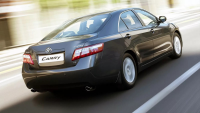

-rear-and-front-view-camera-6.png)

